Ranger Ramblings – June 2025
July 15th 2025
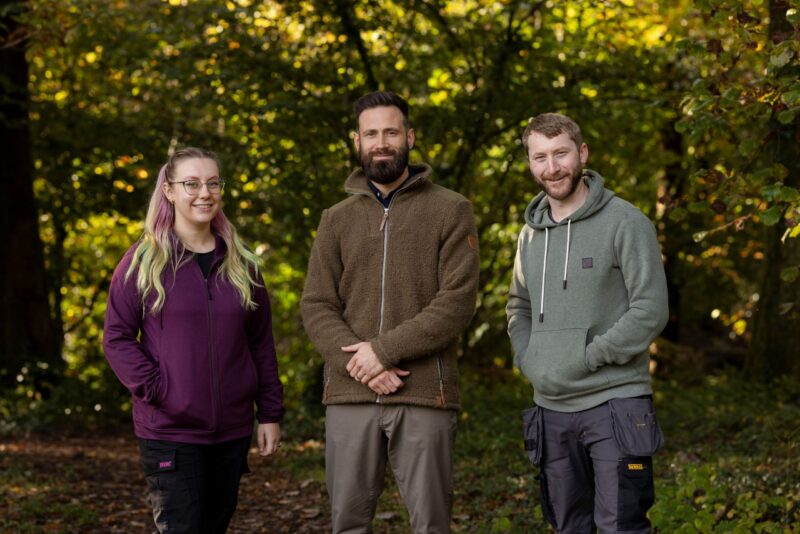
How are we halfway through the year already?! The months have flown by and with the summer holidays looming, we are busier than ever!
Educational trips, ranger events, 30 Days Wild, an extra volunteering meet up, drafting our vision of the park for the next 5 years, and site visits… the list goes on! We are very lucky to be able to work at Bryngarw Country Park, and we are trying our very best to make it a site worth visiting, even if you don’t see the ranger team out and about, we are very busy behind the scenes.
Have you seen any Orchid species (May’s Species of the Month) at Bryngarw Country Park? You can still submit your records to us at Your.Bryngarw@awen-wales.com or directly to SEWBReC.

#30DaysWild for June
You may have noticed that we took part in the Wildlife Trust’s 30 Days Wild challenge through the month of June, where we recommended a different way of connecting with nature and the outdoors for every day.
Although June is over, there is still so many things we can do each day to connect and engage with nature. You can look back on our #30DaysWild challenge ideas on our social media accounts here. Don’t forget to like and follow so that you never miss a post from us.
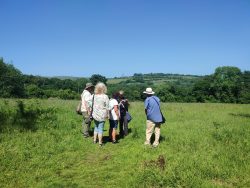
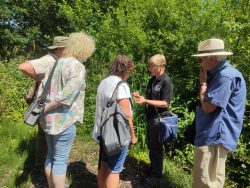
Introduction to the Big Meadow Search and Wildflower ID for Beginners
We had a lovely workshop led by the Big Meadow Search’s founder, Laura Moss earlier this month. It was a lovely walk through the grasslands of the park looking at different identifying features of several flowers and grasses.
The Big Meadow Search is a UK, Ireland and Channel Island project developed by Carmarthenshire Meadows Group, to raise awareness and interest in grasslands and to record plant species. They are also highlighting associations between plants and other species by linking invertebrates and fungi with their host plants. You can get involved by undertaking plant searches on grassland near you and by linking in with our educational social media posts. During the summer months, Laura posts almost daily with lots of handy identification tips and species to look out for!
Thank you Laura, and everyone who attended the session!
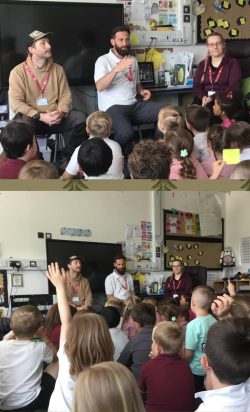
‘How to be a Ranger’ Q&A with Brynmenyn Primary School
Following a school trip where Brynmenyn Primary School pupils took part in a ranger-led Minibeast Hunt and Nature Walk, the ranger team were invited to visit the classroom as part of ‘world of work’ week.
Back in the classroom, the children were given the challenge of writing a ‘how to be a ranger’ guide for us to use for new employees at the park. The ranger team were then invited to the school to see the work and to answer any questions the children had on becoming a park ranger.
We had a lot of interesting questions and we may have to incorporate some of their ‘how to be a ranger’ guidance in our next job advert!
Here is some feedback:
Children – ‘The rangers knew lots and we enjoyed their visit. They told us lots of things about nature. We shared our learning about the jobs we thought park rangers do and checked to see if they did those things.’
School staff – ‘The visit to the park was very engaging. The children also were really engaged and enjoyed the talk. It gave them a great insight into the wonderful work that a ranger does and some children would now like to be a ranger when they grow up. The visit has made the children very enthusiastic about nature.’
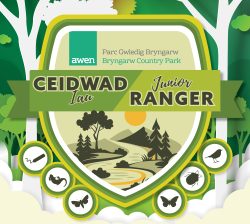
Become a Junior Ranger!
Join the ranger team every Wildlife Wednesday of the summer holidays and work towards your very own Junior Ranger badge!
We are launching our very own Junior Ranger program of events which will run every Wednesday from 10am until 11.30am. Each week will have a different nature-based activity for children to engage with and learn very important skills to become a Bryngarw Junior Ranger.
- 23rd July – Nature Journaling
- 30th July – Pond Dipping
- 6th August – Mighty Moth Trap
- 13th August – Insect Walk
- 20th August – Minibeast Hunt
- 27th August – Bird Watching
For more information and how to book, please visit our What’s On page.
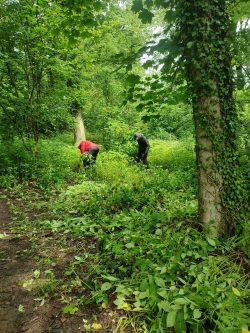
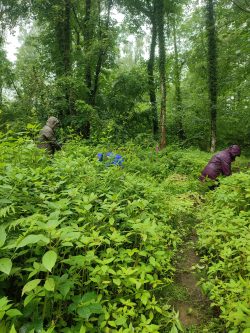
Volunteering Groups
We would not be able to manage our wonderful park without the help of our amazing volunteering groups.
Our Saturday Volunteering group meet on the first Saturday of the month to complete conservation tasks. June’s volunteering session was spent balsam bashing, and there were so many plants to bash, we had an extra session to get ahead of the invasive species.
Balsam and bracken reduce the biodiversity of an area by outcompeting other species such as wildflowers and grasses.
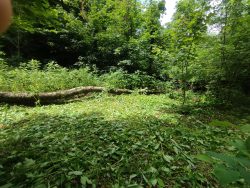
Tuesday Volunteering Group
Another busy month for our weekly volunteering group, thank you to everyone who contributed!
Balsam Pulling! (and other invasive bashing)
As promised, I’m writing about Baslam bashing again. Balsam bashing is the process of pulling, crushing and cutting back Himalayan Balsam so that it doesn’t take over.
Himalayan Balsam is an invasive non-native species which means that it outcompetes native species. Balsam grows in dense stands and it shades out and crowds out many species. It produces much nectar and therefore is attractive to pollinating insects, to the detriment of native flowering plants (which are no longer visited by these insects and thus don’t get pollinated). It also has ‘exploding’ seed pods which scatter seed over large distances, which makes it difficult to control in the later flowering months.
There is some hope though, Balsam is an annual, which means that it only persists for one season/ year and then dies off in the winter. As long as we bash them before they produce the seed pods, we can stop the super spreader in its tracks.
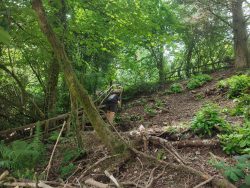
Rhododendron Clearance
Did you know that Bryngarw Country Park is the plant health Sentinel Site for Bridgend?
There are 22 sentinel sites (gardens and parks) across Wales, located in each local authority region, these form the Sentinel Site network. They are important monitoring sites acting as an early warning system for plant pests and diseases, forming a surveillance network. These sites are visited twice a year by Animal and Plant Health Agency to carry out plant health inspections.
Our last visit flagged an infected Rhododendron ponticum. Rhododendron are susceptible to a fungus-like organism called Phytophthora ramorum, which is capable of causing serious damage to a wide range of ornamental and native plants and causes Sudden Oak Death.
We removed the infected rhododendron and burned it onsite to stop the spread. We were happy to hear that on our last visit from the Plant Health Inspector in June that we had no infected plants. But we did spend a Tuesday volunteering session cutting back the regrowth to avoid any reinfections.
What to look out for in July
We have a recording challenge for you! We want to know more about the species we have at Bryngarw Country Park. Once we know what species we have, we can manage the park in a way that better benefits those species and monitor them in future.
In July, we would like you to record your sightings on your walks and submit them to recording apps or to the Ranger team (your.bryngarw@awen-wales.com).
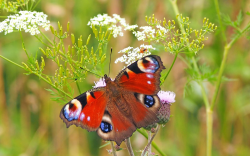
Species of the Month – Peacock Butterfly / Pili Pala Paun (Aglais io)
Named after the feathered friend of the same name, this butterfly is dark with big blue ‘eyes’ which resemble the tailfeathers of a peacock.
A larger butterfly, its wingspan is 6 – 7cm, and is a strong flyer. The eyespots on the forewing evolved to startle and confuse predators. The underside of the wings are very dark and look like dead leaves.
It is on the wing throughout the year, and over winters as an adult. It has one brood in summer, and its caterpillars feed on common nettles, so there is a reason to keep them around!
A very common butterfly, you can spot them on buddlea and other flowers including thistle, betony, bluebell, cuckooflower, dandelion and teas in your gardens, in woodland clearings and edges.
If you spot a Peacock during July (or at any other time of year), please submit your record! Ideally via SEWBReCORD or the LERC Wales App. Instructions on how to submit records are available here.